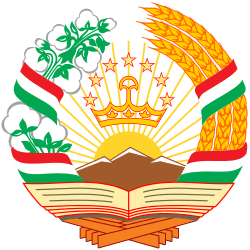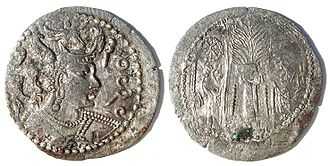Huna people
Part of a series on the |
|---|
| History of Tajikistan |
 |
| Timeline |
| Tajikistan portal |
Part of a series on the |
|---|
| History of Iran |
 |
|
|
|
|
|
|
Related articles |
| Iran portal |
| Outline of South Asian history History of Indian subcontinent | ||||||||||||||||||||||||||||||||||||||||||||||||||||||
|---|---|---|---|---|---|---|---|---|---|---|---|---|---|---|---|---|---|---|---|---|---|---|---|---|---|---|---|---|---|---|---|---|---|---|---|---|---|---|---|---|---|---|---|---|---|---|---|---|---|---|---|---|---|---|
|
Soanian people (500,000 BP)
|
||||||||||||||||||||||||||||||||||||||||||||||||||||||
|
Stone Age (50,000–3000 BC)
|
||||||||||||||||||||||||||||||||||||||||||||||||||||||
|
Bronze Age (3000–1300 BC)
|
||||||||||||||||||||||||||||||||||||||||||||||||||||||
|
Iron Age (1200–26 BC)
|
||||||||||||||||||||||||||||||||||||||||||||||||||||||
|
Classical period (21–1279 AD) |
||||||||||||||||||||||||||||||||||||||||||||||||||||||
|
Late medieval period (1206–1596)
|
||||||||||||||||||||||||||||||||||||||||||||||||||||||
|
Early modern period (1526–1858)
|
||||||||||||||||||||||||||||||||||||||||||||||||||||||
|
Colonial period (1510–1961)
|
||||||||||||||||||||||||||||||||||||||||||||||||||||||
|
Other states (1102–1947)
|
||||||||||||||||||||||||||||||||||||||||||||||||||||||
|
Kingdoms of Sri Lanka
|
||||||||||||||||||||||||||||||||||||||||||||||||||||||
|
Nation histories |
||||||||||||||||||||||||||||||||||||||||||||||||||||||
|
Specialised histories |
||||||||||||||||||||||||||||||||||||||||||||||||||||||

Obv: Napki Malka type bust, winged headdress with bull head in the center. Pahlavi legend "NAPKI MALKA".
Rev: Zoroastrian fire altar with attendants either side. Sun wheel, or possibly eight-spoked Buddhist Dharmacakra, above left.
The Hunas were Iranian-speaking Xionite tribes who, via Khyber Pass, entered India at the end of the 5th or early 6th century and were defeated by the Indian Gupta Empire and the Indian king Yasodharman.[2] In its farthest geographical extent in India, the Huna empire covered the region up to Malwa in central India.[3]
History

The Central Asian Xionites consisted of four hordes in four cardinal directions. Northern Huna were the Black Huns, Southern Huna were the Red Huns, Eastern Huna were the Celestial Huns, and Western Huna were the White Huns or Hephthalites. This article mainly concerns the Alchon and their Indo-Hephthalite ruling-elite. They seem to have been part of the Hephthalite group, who established themselves in then Bharatvarsha and present day India by the first half of the 5th century. They sometimes call themselves "Hono" on their coins, but it seems that they are similar to the Huns who invaded the Western world.
They appeared in Northwestern India and parts of eastern Iran. During their invasion, the Hunas managed to capture the Sassanian king Peroz I, and exchanged him for a ransom. They used the coins of the ransom to counter mark and copy them, thereby initiating a coinage inspired from Sassanian designs.[4]
The Bhishma Parva of the Mahabharata, supposed to have been edited around the 4th or 5th century, in one of its verses, mentions the Hunas with the Parasikas and other Mlechha tribes of the northwest including the Yavanas, Chinas, Kambojas, Darunas, Sukritvahas, Kulatthas etc. According to Dr V. A. Smith, the verse is reminiscent of the period when the Hunas first came into contact with the Sassanian dynasty of Persia.[5]
Scholars believe that king Raghu, the hero of Kalidasa's Sanskrit play Raghuvamsha was in fact king Chandragupta Vikramaditya of the Gupta Dynasty. According to the epic, he had started a military expedition and after defeating and subjugating the local peoples along the way he reached the Parasikas of Sassanian Iran and defeated them after fierce fighting. Then he proceeded to north from Iran and reached river Vamkshu (or Oxus) where he battled with the Hunas. After conquering the Hunas, he crossed the Oxus and encountered the Kambojas, an ancient Iranian people who find frequent mention in South Asian texts.
Brihat Katha Manjari of Kashmiri Pandit Kshmendra (11th century AD) also claims that king Vikramaditya had slaughtered the Shakas, Barbaras, Hunas, Kambojas, Yavanas, Parasikas and the Tusharas etc. and hence unburdened the earth of these sinful Mlechhas. There is still another ancient Brahmanical text Katha-Saritsagara by Somadeva which also attests that king Vikramaditya had invaded the north-west tribes including the Kashmiras and had destroyed the Sanghas of the Mlechhas (reference to Sanghas here obviously alludes to the Sanghas of the Madrakas, Yaudheyas, Kambojas, Mallas or Malavas, Sibis, Arjunayans, Kulutas and Kunindas etc). Those who survived accepted his suzerainty and many of them joined his armed forces.
Skandagupta is stated to have repelled a Huna invasion in 455, but they continued to pressure South Asia's northwest frontier (present day Pakistan), and broke through into northern India by the end of the 5th century, hastening the disintegration of the Gupta Empire.
According to Litvinsky, the initial Huna or Alxon raids on Gandhara took place in the late 5th and early 6th century AD, upon the death of the Gupta ruler, Skandagupta (455–470), presumably led by the Tegin Khingila. M. Chakravary, based on Chinese and Persian histories believes that the Hunas conquered Gandhara from the Ki-to-lo (Kidarites) in c. 475 AD. Gandhara had been occupied by various Kidarite principalities from the early 4th century AD, but it is still a subject of debate as to whether rule was transferred from the Kidarites directly to the Hephthalites. It is known that the Huns invaded Gandhara and the Punjab from the Kabul valley after vanquishing the Kidarite principalities.
The Alchon ruler Toramana established his rule over Gandhara and western Punjab, and was succeeded by his son Mihirakula in 520 whose capital was Sakala or modern day Sialkot in the Pakistani Punjab. The Guptas continued to resist the Hunas, and allied with the rulers of the neighboring Indian states.
The Hunas suffered a defeat by Yasodharman of Malwa in 528, and by 542 Mihirakula had been driven off the plains of northern India, taking refuge in Kashmir, and he is thought to have died soon after. Mihirakula is remembered in contemporary Indian and Chinese histories for his cruelty and his destruction of temples and monasteries, with particular hostility towards Buddhism.

The Huna were further defeated around 565 by a coalition of Sassanians and Western Turks.
After the end of the 6th century little is recorded in India about the Huna. They may have had matrimonial alliance with Gurjars and others cite as them being assimilated into the dominant Gurjar community. Huna is one minor gotra among Gurjars.
In northwestern India, the Rajputs formed "as a result of the merging of the Hephthalites and the Gujars with population from northwestern India."[6] However, this is disputed and indegenious theory also prevails postulating as the reasserting of Hindu/Vedic authority in the political scenario of India.[7][8][9][10]
King Devapala of Pala dynasty of Bengal (810 AD −850 AD) is said to have invaded and received tributes from the Vindhyas, Dravidas, Hunas, Gurjaras and Kambojas in the West.[11]
The Hunas are mentioned in the Tibetan chronicle Dpag-bsam-ljon-bzah (The Excellent Kalpa-Vrksa), along people like the Yavanas, Kambojas, Tukharas, Khaqsas, Daradas etc.[12][13]
Religion
The Hunas were fervent worshippers of the Vedic Sun God and Shiva.[14]
Sung Yun and Hui Sheng, who visited the chief of the Hephthalite nomads at his summer residence in Badakshan and later in Gandhara, observed that they had no belief in the Buddhist law and served a large number of divinities."[15]
See also
- 36 royal races
- Ancient India and Central Asia
- Hon
- History of India
- History of Central Asia
- Raghuvaṃśa
- gurjar
Notes
- ↑ Iaroslav Lebedynsky, "Les Nomades", p172.
- ↑ India: A History by John Keay p.158
- ↑ Kurbanov, Aydogdy (2010). "The Hephthalites: Archaeological and Historical Analysis" (PDF). p. 24. Retrieved 17 January 2013.
The Hūnas controlled an area that extended from Malwa in central India to Kashmir.
- ↑ Source
- ↑ Early History of India, p 339, Dr V. A. Smith; See also Early Empire of Central Asia (1939), W. M. McGovern.
- ↑ Kurbanov, Aydogdy (2010). "The Hephthalites: Archaeological and Historical Analysis" (PDF). p. 243. Retrieved 11 January 2013.
As a result of the merging of the Hephthalites and the Gujars with population from northwestern India, the Rajputs (from Sanskrit “rajputra” – “son of the rajah”) formed.
- ↑ Studies In Indian History: Rajasthan Through The Ages The Heritage Of Rajputs By R.K. Gupta, S.R. Bakshi.
- ↑ "Saturday, July 08, 2006 Rajput rule of India is described. Rajput battles against Islamic invaders are covered in depth.". Digvijay.
- ↑ "RAJPUT HISTORY". Hina.
- ↑ "Rajputs—Aliens or Indigenous ?". http://www.academia.edu''. Dr. Gopal Singh Rathore.
- ↑ Ancient India, 2003, p 650, Dr V. D. Mahajan; History and Culture of Indian People, The Age of Imperial Kanauj, p 50, Dr R. C. Majumdar, Dr A. D. Pusalkar.
- ↑ Tho-gar yul dań yabana dań Kambodza dań Khasa dań Huna dań Darta dań...
- ↑ Pag-Sam-Jon-Zang (1908), I.9, Sarat Chandra Das; Ancient Kamboja, 1971, p 66, H. W. Bailey.
- ↑ History of civilizations of Central Asia, Volume 3 By Boris Abramovich Litvinovskiĭ Page 173
- ↑ "The White Huns - The Hephthalites". Silkroad Foundation. Retrieved 11 January 2013.
References
- Iaroslav Lebedynsky, "Les Nomades", Paris 2007, ISBN 978-2-87772-346-6
External links
- Hephthalite coins
- More Hephthalite coins
- Alchon Hunnic History and Coins of the Kashmir Smast Kingdom- Waleed Ziad
| ||||||||||